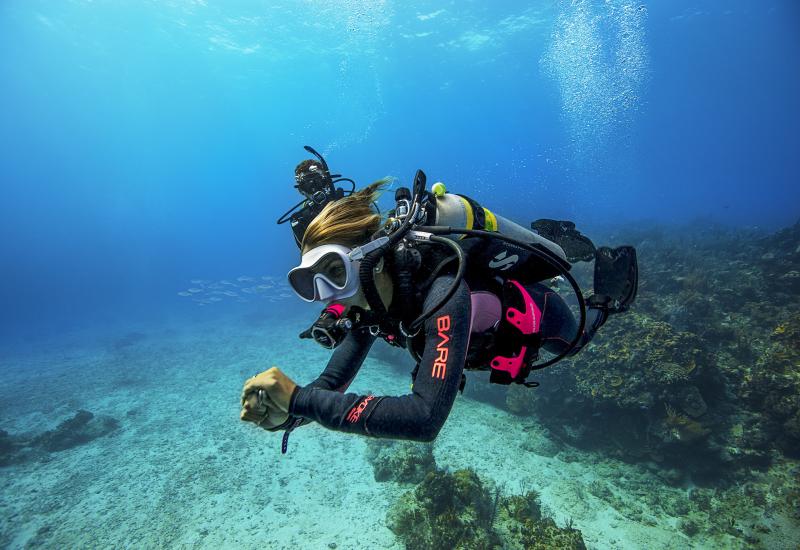Night Diving Skills
 |
| Not afraid of the dark, are you? Photography by Stephen Frink |
In the last of the fading light, hundreds of blue tang gather from all directions and stream single-file over the edge of the reef. Hundreds more rush in and join the stream like concertgoers crowding through a turnstile. Soon, the tiny fish form dense swirling clusters like a dance floor out of control. As if responding to an unheard beat, frantic balls of fish surge up toward the surface, subside, and surge upward again, finally emitting a cloud of sperm and eggs in something like a huge simultaneous orgasm.
And you thought the nightlife at the pool bar was wild.
When the sun goes down, even a ho-hum reef can turn into the underwater equivalent of the Las Vegas strip. Coral polyps, cowering wallflowers of the daytime, spread their brightly colored tentacles to hook up with plankton under a bioluminescent light show. Predators arrive to do their dirty work under cover of darkness, while prey hide in the shadows. And sex? It's everywhere.
You can crash this party, but you'll enjoy it more if you know a few of the crazies down there. See "Nightcrawlers" for a dusk-to-dawn overview of who's who. Equipping yourself for a night dive is the easy part; just pull out the plastic. Gear heads will drool over the dive lights featured in "Got a Light?"--a rundown of our picks for practical illumination. Harder to acquire is a smooth night-dive technique. We can help you there, too, with "The Essential Rules of Night Diving." Finally, we'll whet your appetite for a little wet fun with "Nine Nights to Remember," a hand-picked sampler of dive sites and experiences where sparks fly, mantas dance and the water glows.
The sun will be setting again soon. You can perch on a barstool reliving old dive memories, or you can get out there and create some exciting new ones. The choice is yours. Just remember our mantra: Real divers do it in the dark.
The Essential Rules of Night Diving
GO LITE ON THE LIGHT. A lot of divers cling to their lights like security blankets, and that's a mistake. When you reach the bottom, turn off your beam and see how much ambient light there is. (Or press it against your stomach or chest to "snuff" it. Lights are most likely to fail when you operate the switch, so minimize the on/off cycles.)
In any case, give your eyes a minute to adjust and you may be surprised. The lights of other divers, the moon and even the stars can provide so much ambient light you really don't need your dive light on. With it off, you'll see more fish not fewer, and coral polyps and anemones will keep their tentacles extended.
If you do need a light, you may not need its full power. Try dimming it by cupping your fingers over it. In any case, use the edge of the pool of light, not the "hot spot," to pick out critters. Bottom line: To see nature's nightlife, be more natural yourself. Use minimal artificial light and instead try to get by as the other night creatures do, with nature's light.
TREAT YOUR LIGHT LIKE A LOADED GUN. Don't shine your light in anyone's face (including your own) or you'll ruin their night vision.
KNOW THE SIGNALS. Hand signals will be difficult or impossible to see, so put your light to good use. Making a circle with the beam means "OK," waving it side to side calls for attention, and waving it up and down calls for help. If you're at close range, turn the beam on your hand to illuminate traditional signals. Just remember rule #2 whenever you signal with a light.
KNOW THE DRILL. Should you become separated from your buddy, get vertical and shine your light outward while turning a full circle. Your buddy should do the same and one of you will see the glow of the other's light. If you surface far from the dive boat, point it at the boat only until you get attention, then shine it down on your head. Shining it at the boat just blinds the crew and makes you invisible.
GET A STRAP. Secure your light to your wrist with a lanyard--it's cheap insurance against dropping and losing your primary source of illumination. Most dive lights are negatively buoyant. When you let go, they will drop and dangle from your wrist. If you need to free up a hand, turn the beam off before you drop the light. That way, you won't blind other divers or send confusing signals to your buddy.
DON'T USE YOUR DIVE LIGHT TOPSIDE. Some dive lights burn so hot that they will melt their reflectors and lenses without the cooling effect of water. Save the bulb and the battery life of your dive light by using a regular flashlight for topside tasks.
DON'T JUMP IN HOLDING YOUR LIGHT. Have someone hand it down to you. The impact of a giant stride may jar your light's O-ring and let water seep in.
STAY CLOSE TO YOUR BUDDY. You might need a third hand to hold a light while you refasten a buckle or stuff a lobster in a bag.
SNAP YOUR CONSOLE TO A D-RING. That way, you can read it no-hands. Or try a retractor that pulls your gauge console back to the same position when you let go. This eliminates the need to fumble for gauges in the dark.
CHECK INSTRUMENTS MORE OFTEN. Without a clear visual reference, it's easy to drift upward or downward without realizing it. In the excitement, you might also find yourself using air faster than normal.
START YOUR DIVE AT TWILIGHT. You'll have the best of both worlds: Dim light to gear up in and full dark will come while you dive. You'll also have the chance to see the reef make the transition from the day shift to the night shift, one of the most exciting periods of activity.
STAY SHALLOW. Always a good idea when it's your fourth or fifth dive of the day, but there's a better reason: more bottom time. You came to see the show, so why not make it last as long as you can?
Night Crawlers
 |
The approach of evening brings a shift change on the reef and what Joseph Levine, author of The Coral Reef at Night, aptly calls "the hustle, bustle and confusion common to rush hour in big cities." Here's what to expect on a Caribbean reef:
-
AT TWILIGHT: Hunters from both daytime and nighttime shifts look for quick kills in the confusion. Reef sharks, for example, hug the reef so their prey is silhouetted against the twilit surface. As daytime fish settle in for the night, defenses go up. Triggerfish dive into crevasses and erect dorsal spines to lock themselves in place. Parrotfish wrap themselves in a blanket of repellent mucus. Mating also takes place in the fading light. Surgeonfish, grouper and wrasse engage in "spawning rises," ejecting bursts of eggs and sperm into the water.
-
DURING PRIME TIME. In full darkness, corals and gorgonians expand their bodies and blossom with flower-like polyps and stinging tentacles, hoping to catch drifting plankton. Nudibranchs, unprotected by shells, come out to graze. Crabs, lobsters, brittle stars and urchins leave their holes to feed and mate. Octopuses and seahorses become more active.
-
AFTER MIDNIGHT: As dawn approaches, the movie spools in reverse. Grunts and groupers return to their holes, while sleeping parrotfish begin to stir. Soft and hard corals wilt and retract as the light grows stronger. Twilight hunters assault the morning rush hour, but soon lose their edge over the daytime reef fish streaming from their cracks and caves. The familiar daytime population reappears and the cycle begins anew.
Are You Afraid of the Dark?
Most divers are, at first. We're daytime creatures, and peering into a black night sea is naturally disconcerting. Experience will help you get over it. In the meantime, it helps to minimize the stresses. Choose a calm night and follow a modest profile. Start at twilight when there's still a little light for gearing up and getting comfortable. Take it slow and easy. Keep it simple at first--no cameras or hunting gear.
 |
| In-flight meal and entertainment: Mantas swoop in to feed on plankton while you enjoy the show. Photography by Doug Perrine |
Nine Nights to Remember
1) DANCE WITH THE MANTAS. Off the Kona Coast of Hawaii's Big Island, dive operators place powerful lights on the bottom to attract plankton. Before long, stealthy black manta rays swoop in out of the dark to feed, mesmerizing divers with graceful acrobatics. "I still get chills just thinking about it," says diver Jim Scalzo. You can do the same thing on any ocean night dive, though there's no guarantee you'll see mantas. Turn your light on, put it on a rock to attract plankton and wait. Set your camera for wide-angle and be ready for anything.
2) MAKE SPARKS FLY. On any ocean dive, turn your light off and look for bioluminescence. Sometimes it's dots of various colors flashing on and off. Sometimes it's fields of various colors. Sometimes the body of a fish (or a diver) will glow as it excites luminescent plankton it swims through. Wave your hand in front of your face and watch the sparks fly.
3) DIVE INTO AN ORGY. Predictability and an abundance of star and brain corals make the Flower Garden Banks National Marine Sanctuary the most spectacular place to watch mass coral spawning. The "big bang" starts just after sunset between three and eight nights after the August full moon. Corals erupt with BB-sized egg packets and cloudy wisps of sperm that float toward the surface in a reverse blizzard. The rest of the marine life goes wild too. Brittle stars and lobster go into a feeding frenzy, passing eggs to their mouths as fast as they can catch them, while several fish species get "in the mood" for a little procreating of their own. "It's an undersea orgy of birth, death and rejuvenation," says diver J.D. Barnett of New Mexico.
4) GO TO THE LIBRARY. This wall dive, located just 200 yards off Cockburn Town, Grand Turk, has an abundance of orange ball corallimorphs, tube-dwelling creatures that hide during the day, but extend at night to feed. You'll be greeted by hundreds of one- to two-inch arms, each tipped with a bright orange ball, waving in the currents.
5) SWIM IN BLUE NEON. For the full light show, break out your snorkel and head for Bioluminescent Bay on the island of Vieques, Puerto Rico. Each gallon of water in the sheltered bay contains 720,000 dinoflagellates, and the microscopic creatures flash bluish light when agitated by motion. Learn more at www.biobay.com.
 |
| Take a NightSea filter on your next dive to bring out the reef's grooviest colors. Photography by Ethan Gordon |
6) MAKE IT DAY-GLO. Many corals and even some fish fluoresce with weird psychedelic colors when hit with specially filtered light. Day-Glo oranges and greens like you've never seen before pop out of the most mundane critters. To see the show, get the filters from a company called NightSea (www.nightsea.com or (877) 436-9262). You can even capture these effects on film.
7) TAKE A STROLL UNDER THE PIER. Bonaire's Kralendijk Town Pier is one of the world's most photographed night dives and for good reason--the pilings are smothered with orange cup corals, and the polyps extend only at night. Piling residents also include enormous yellow and purple tube sponges, oysters, trumpetfish and encrusting sponges in all shapes and sizes.
8) WATCH DUANE BLUSH. The hull of the U.S. Coast Guard Cutter Duane, resting in 120 feet of water off Key Largo, Fla., is covered in orange cup corals. When the polyps extend at night, the wreck looks like it's wearing an orange life preserver.
9) BAG YOUR BUG LIMIT. At the stroke of midnight on the first day of lobster season, you'll find eager bug hunters mid-giant stride on their favorite reef. Not only are these divers getting a leg up on the rest of us, they're also taking advantage of the fact that lobsters are nocturnal. The odds of catching them increase when you dive at night.
Got a Light?
These dive lights have all earned the coveted Scuba Diving Testers' Choice rating in past Scuba Lab tests.
- BIG PRIMARY DIVE LIGHT. Underwater Kinetics Light Cannon 100. Aptly named, this was Scuba Lab's choice for large, pistol- or lantern-grip lights. Powered by eight C-cells, the Light Cannon 100's high-intensity discharge (HID) bulb is brighter, whiter and smoother than incandescent bulbs. Used with a diffusion filter (included), it's a good primary light in clear, tropical conditions and can even double as a close-range video light. Use it without the filter for deep water or murky conditions. Price: About $280.
 |
-
MEDIUM PRIMARY DIVE LIGHT. Princeton Tec's Tec 400. Perfect as a mid-sized primary dive light in clear water (or a back-up in murky conditions), the Tec 400 runs on four C-cells. An efficient incandescent bulb produces a bright hotspot, good peripheral illumination and no misleading shadows. Price: About $35. Close runner-up: Ikelite PCa, a bright, palm-sized light that takes 6 AA batteries, about $30.
-
MARKER LIGHT. Innovative Scuba VIP Safety Light. Amber LEDs make this marker light unusually bright yet energy-efficient. Price: About $80. Close runner-up: Innovative Scuba Versa-Lite, about $13.
-
TOPSIDE FLASHLIGHT. Tektite Expedition 1900. Save your dive light for underwater use. Topside, use this waterproof, drop-proof beam to find your way to the dock and rummage through your dive bag. Nineteen LEDs offer a long burn time and a wide, smooth light pattern. Price: About $116.
-
Look for a floodlight, not a spotlight. Most of the time, you want to bathe a large area up-close with light, not pick out a dot at long distance.
-
Look for a smooth, featureless pool of light. A smooth pool is important because shadows of the filament or reflector when painted on the reef can be misleading.
-
In general, look for more batteries (six or eight) if you want a brighter light; look for bigger batteries (C or D cells) if you want longer burn time.
-
Bulbs and reflectors being equal, high intensity discharge bulbs are almost always much brighter than conventional incandescents, while LEDs are much easier on batteries.
-
Look for a one-finger on/off switch. Twist types require an extra hand.
Light Buying Tips
 |
| Now closed, you used to find Bonaire's best nightlife under Town Pier. |
Book: The Coral Reef at Night, by Joseph Levine and photography by Jeffrey L. Rotman. Hardcover, 192 pages, $39.95.
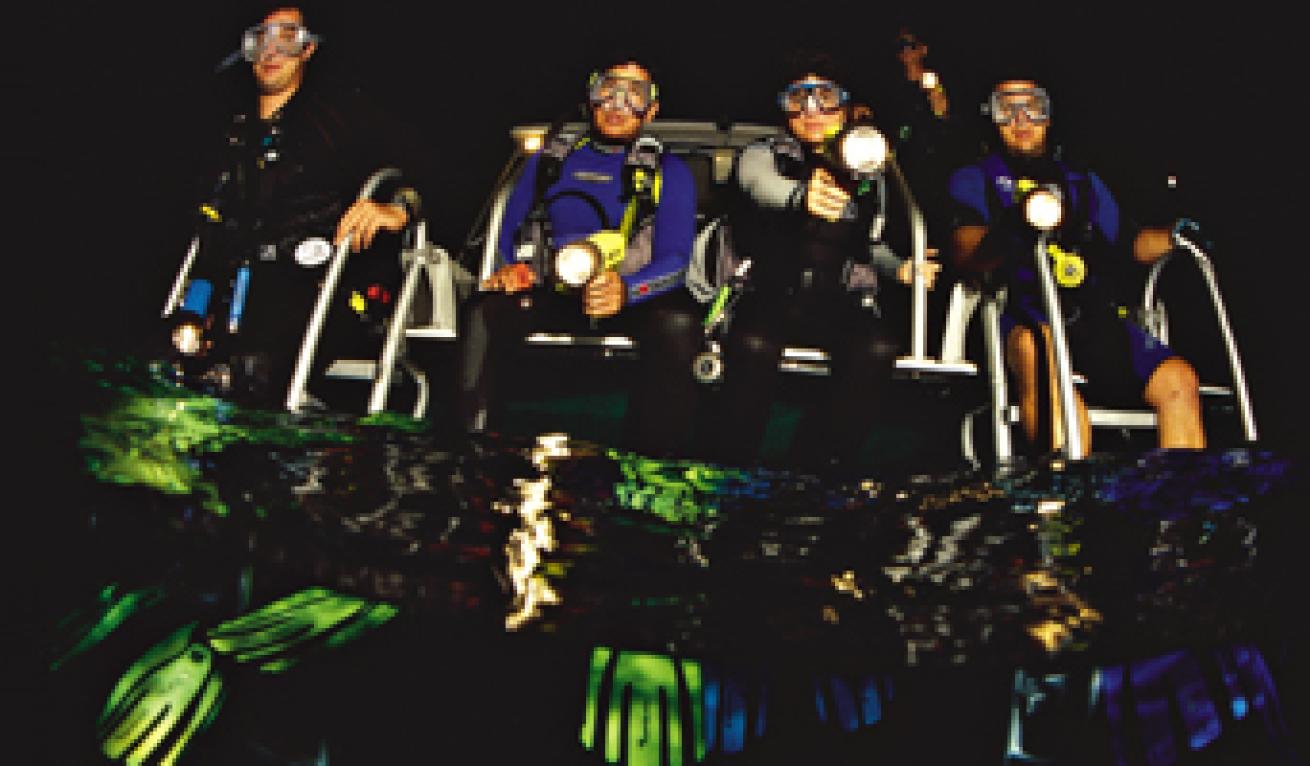
Not afraid of the dark, are you? Photography by Stephen Frink
In the last of the fading light, hundreds of blue tang gather from all directions and stream single-file over the edge of the reef. Hundreds more rush in and join the stream like concertgoers crowding through a turnstile. Soon, the tiny fish form dense swirling clusters like a dance floor out of control. As if responding to an unheard beat, frantic balls of fish surge up toward the surface, subside, and surge upward again, finally emitting a cloud of sperm and eggs in something like a huge simultaneous orgasm.
And you thought the nightlife at the pool bar was wild.
When the sun goes down, even a ho-hum reef can turn into the underwater equivalent of the Las Vegas strip. Coral polyps, cowering wallflowers of the daytime, spread their brightly colored tentacles to hook up with plankton under a bioluminescent light show. Predators arrive to do their dirty work under cover of darkness, while prey hide in the shadows. And sex? It's everywhere.
You can crash this party, but you'll enjoy it more if you know a few of the crazies down there. See "Nightcrawlers" for a dusk-to-dawn overview of who's who. Equipping yourself for a night dive is the easy part; just pull out the plastic. Gear heads will drool over the dive lights featured in "Got a Light?"--a rundown of our picks for practical illumination. Harder to acquire is a smooth night-dive technique. We can help you there, too, with "The Essential Rules of Night Diving." Finally, we'll whet your appetite for a little wet fun with "Nine Nights to Remember," a hand-picked sampler of dive sites and experiences where sparks fly, mantas dance and the water glows.
The sun will be setting again soon. You can perch on a barstool reliving old dive memories, or you can get out there and create some exciting new ones. The choice is yours. Just remember our mantra: Real divers do it in the dark.
The Essential Rules of Night Diving
GO LITE ON THE LIGHT. A lot of divers cling to their lights like security blankets, and that's a mistake. When you reach the bottom, turn off your beam and see how much ambient light there is. (Or press it against your stomach or chest to "snuff" it. Lights are most likely to fail when you operate the switch, so minimize the on/off cycles.)
In any case, give your eyes a minute to adjust and you may be surprised. The lights of other divers, the moon and even the stars can provide so much ambient light you really don't need your dive light on. With it off, you'll see more fish not fewer, and coral polyps and anemones will keep their tentacles extended.
If you do need a light, you may not need its full power. Try dimming it by cupping your fingers over it. In any case, use the edge of the pool of light, not the "hot spot," to pick out critters. Bottom line: To see nature's nightlife, be more natural yourself. Use minimal artificial light and instead try to get by as the other night creatures do, with nature's light.
TREAT YOUR LIGHT LIKE A LOADED GUN. Don't shine your light in anyone's face (including your own) or you'll ruin their night vision.
KNOW THE SIGNALS. Hand signals will be difficult or impossible to see, so put your light to good use. Making a circle with the beam means "OK," waving it side to side calls for attention, and waving it up and down calls for help. If you're at close range, turn the beam on your hand to illuminate traditional signals. Just remember rule #2 whenever you signal with a light.
KNOW THE DRILL. Should you become separated from your buddy, get vertical and shine your light outward while turning a full circle. Your buddy should do the same and one of you will see the glow of the other's light. If you surface far from the dive boat, point it at the boat only until you get attention, then shine it down on your head. Shining it at the boat just blinds the crew and makes you invisible.
GET A STRAP. Secure your light to your wrist with a lanyard--it's cheap insurance against dropping and losing your primary source of illumination. Most dive lights are negatively buoyant. When you let go, they will drop and dangle from your wrist. If you need to free up a hand, turn the beam off before you drop the light. That way, you won't blind other divers or send confusing signals to your buddy.
DON'T USE YOUR DIVE LIGHT TOPSIDE. Some dive lights burn so hot that they will melt their reflectors and lenses without the cooling effect of water. Save the bulb and the battery life of your dive light by using a regular flashlight for topside tasks.
DON'T JUMP IN HOLDING YOUR LIGHT. Have someone hand it down to you. The impact of a giant stride may jar your light's O-ring and let water seep in.
STAY CLOSE TO YOUR BUDDY. You might need a third hand to hold a light while you refasten a buckle or stuff a lobster in a bag.
SNAP YOUR CONSOLE TO A D-RING. That way, you can read it no-hands. Or try a retractor that pulls your gauge console back to the same position when you let go. This eliminates the need to fumble for gauges in the dark.
CHECK INSTRUMENTS MORE OFTEN. Without a clear visual reference, it's easy to drift upward or downward without realizing it. In the excitement, you might also find yourself using air faster than normal.
START YOUR DIVE AT TWILIGHT. You'll have the best of both worlds: Dim light to gear up in and full dark will come while you dive. You'll also have the chance to see the reef make the transition from the day shift to the night shift, one of the most exciting periods of activity.
STAY SHALLOW. Always a good idea when it's your fourth or fifth dive of the day, but there's a better reason: more bottom time. You came to see the show, so why not make it last as long as you can?
Night Crawlers

The approach of evening brings a shift change on the reef and what Joseph Levine, author of The Coral Reef at Night, aptly calls "the hustle, bustle and confusion common to rush hour in big cities." Here's what to expect on a Caribbean reef:
AT TWILIGHT: Hunters from both daytime and nighttime shifts look for quick kills in the confusion. Reef sharks, for example, hug the reef so their prey is silhouetted against the twilit surface. As daytime fish settle in for the night, defenses go up. Triggerfish dive into crevasses and erect dorsal spines to lock themselves in place. Parrotfish wrap themselves in a blanket of repellent mucus. Mating also takes place in the fading light. Surgeonfish, grouper and wrasse engage in "spawning rises," ejecting bursts of eggs and sperm into the water.
DURING PRIME TIME. In full darkness, corals and gorgonians expand their bodies and blossom with flower-like polyps and stinging tentacles, hoping to catch drifting plankton. Nudibranchs, unprotected by shells, come out to graze. Crabs, lobsters, brittle stars and urchins leave their holes to feed and mate. Octopuses and seahorses become more active.
AFTER MIDNIGHT: As dawn approaches, the movie spools in reverse. Grunts and groupers return to their holes, while sleeping parrotfish begin to stir. Soft and hard corals wilt and retract as the light grows stronger. Twilight hunters assault the morning rush hour, but soon lose their edge over the daytime reef fish streaming from their cracks and caves. The familiar daytime population reappears and the cycle begins anew.
Are You Afraid of the Dark?
Most divers are, at first. We're daytime creatures, and peering into a black night sea is naturally disconcerting. Experience will help you get over it. In the meantime, it helps to minimize the stresses. Choose a calm night and follow a modest profile. Start at twilight when there's still a little light for gearing up and getting comfortable. Take it slow and easy. Keep it simple at first--no cameras or hunting gear.
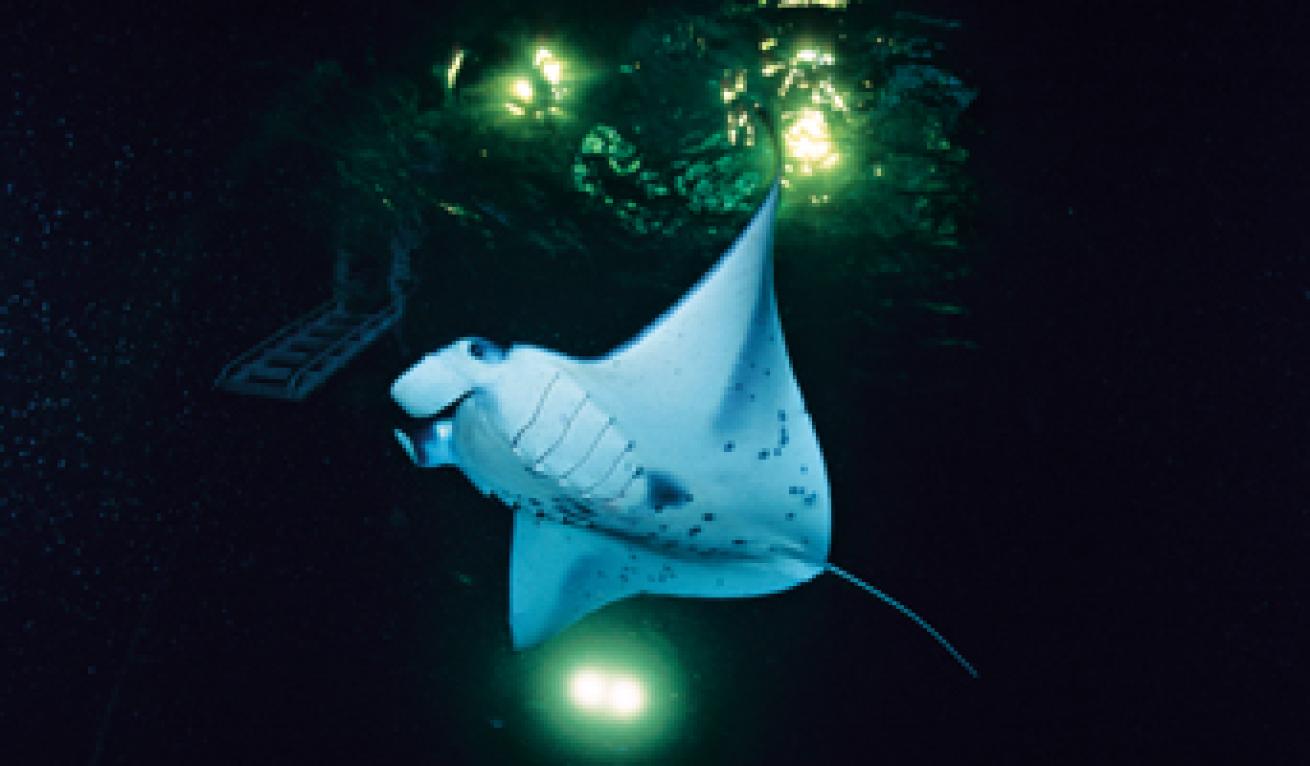
In-flight meal and entertainment: Mantas swoop in to feed on plankton while you enjoy the show. Photography by Doug Perrine
Nine Nights to Remember
1) DANCE WITH THE MANTAS. Off the Kona Coast of Hawaii's Big Island, dive operators place powerful lights on the bottom to attract plankton. Before long, stealthy black manta rays swoop in out of the dark to feed, mesmerizing divers with graceful acrobatics. "I still get chills just thinking about it," says diver Jim Scalzo. You can do the same thing on any ocean night dive, though there's no guarantee you'll see mantas. Turn your light on, put it on a rock to attract plankton and wait. Set your camera for wide-angle and be ready for anything.
2) MAKE SPARKS FLY. On any ocean dive, turn your light off and look for bioluminescence. Sometimes it's dots of various colors flashing on and off. Sometimes it's fields of various colors. Sometimes the body of a fish (or a diver) will glow as it excites luminescent plankton it swims through. Wave your hand in front of your face and watch the sparks fly.
3) DIVE INTO AN ORGY. Predictability and an abundance of star and brain corals make the Flower Garden Banks National Marine Sanctuary the most spectacular place to watch mass coral spawning. The "big bang" starts just after sunset between three and eight nights after the August full moon. Corals erupt with BB-sized egg packets and cloudy wisps of sperm that float toward the surface in a reverse blizzard. The rest of the marine life goes wild too. Brittle stars and lobster go into a feeding frenzy, passing eggs to their mouths as fast as they can catch them, while several fish species get "in the mood" for a little procreating of their own. "It's an undersea orgy of birth, death and rejuvenation," says diver J.D. Barnett of New Mexico.
4) GO TO THE LIBRARY. This wall dive, located just 200 yards off Cockburn Town, Grand Turk, has an abundance of orange ball corallimorphs, tube-dwelling creatures that hide during the day, but extend at night to feed. You'll be greeted by hundreds of one- to two-inch arms, each tipped with a bright orange ball, waving in the currents.
5) SWIM IN BLUE NEON. For the full light show, break out your snorkel and head for Bioluminescent Bay on the island of Vieques, Puerto Rico. Each gallon of water in the sheltered bay contains 720,000 dinoflagellates, and the microscopic creatures flash bluish light when agitated by motion. Learn more at www.biobay.com.
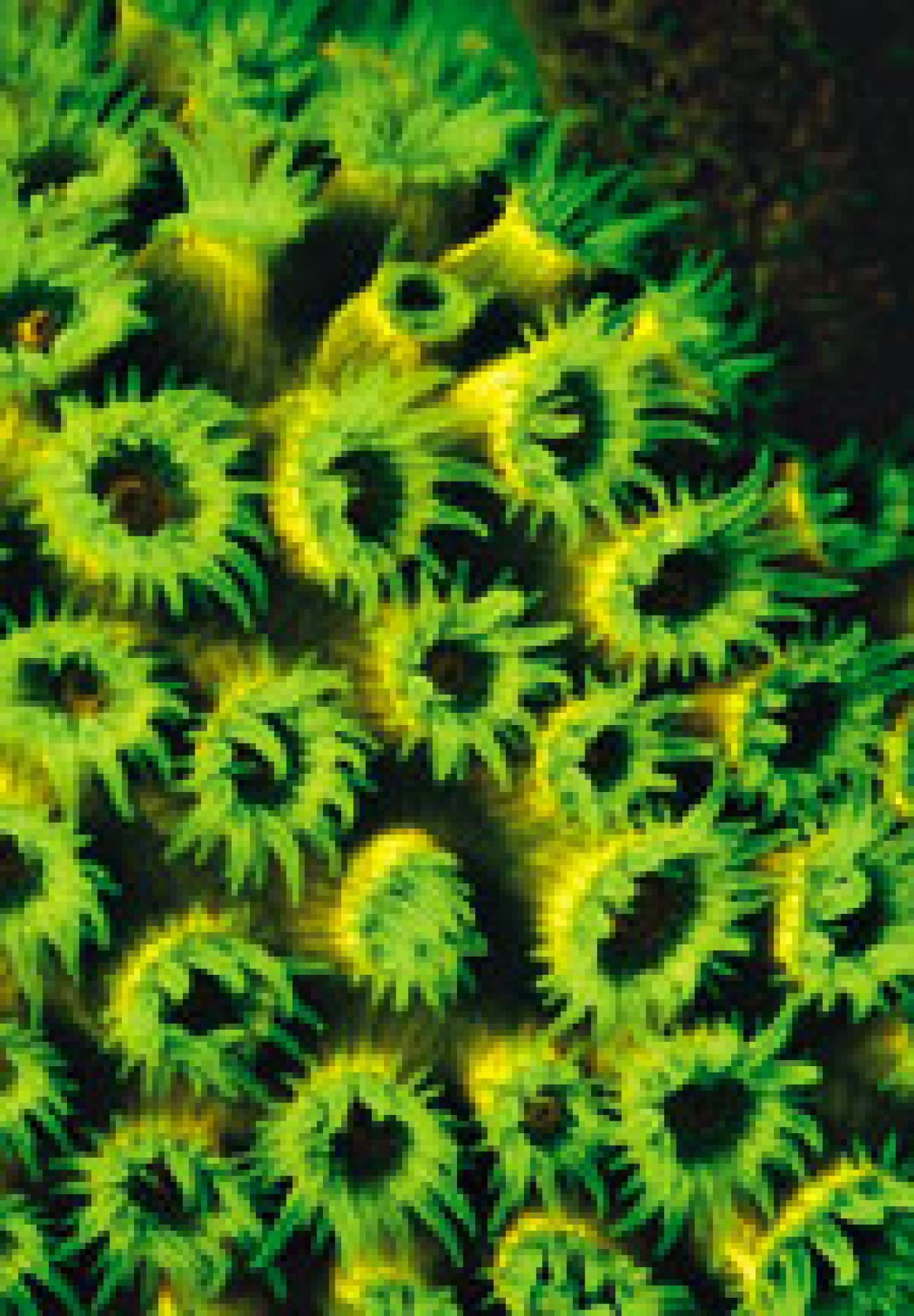
Take a NightSea filter on your next dive to bring out the reef's grooviest colors. Photography by Ethan Gordon
6) MAKE IT DAY-GLO. Many corals and even some fish fluoresce with weird psychedelic colors when hit with specially filtered light. Day-Glo oranges and greens like you've never seen before pop out of the most mundane critters. To see the show, get the filters from a company called NightSea (www.nightsea.com or (877) 436-9262). You can even capture these effects on film.
7) TAKE A STROLL UNDER THE PIER. Bonaire's Kralendijk Town Pier is one of the world's most photographed night dives and for good reason--the pilings are smothered with orange cup corals, and the polyps extend only at night. Piling residents also include enormous yellow and purple tube sponges, oysters, trumpetfish and encrusting sponges in all shapes and sizes.
8) WATCH DUANE BLUSH. The hull of the U.S. Coast Guard Cutter Duane, resting in 120 feet of water off Key Largo, Fla., is covered in orange cup corals. When the polyps extend at night, the wreck looks like it's wearing an orange life preserver.
9) BAG YOUR BUG LIMIT. At the stroke of midnight on the first day of lobster season, you'll find eager bug hunters mid-giant stride on their favorite reef. Not only are these divers getting a leg up on the rest of us, they're also taking advantage of the fact that lobsters are nocturnal. The odds of catching them increase when you dive at night.
Got a Light?
These dive lights have all earned the coveted Scuba Diving Testers' Choice rating in past Scuba Lab tests.
- BIG PRIMARY DIVE LIGHT. Underwater Kinetics Light Cannon 100. Aptly named, this was Scuba Lab's choice for large, pistol- or lantern-grip lights. Powered by eight C-cells, the Light Cannon 100's high-intensity discharge (HID) bulb is brighter, whiter and smoother than incandescent bulbs. Used with a diffusion filter (included), it's a good primary light in clear, tropical conditions and can even double as a close-range video light. Use it without the filter for deep water or murky conditions. Price: About $280.
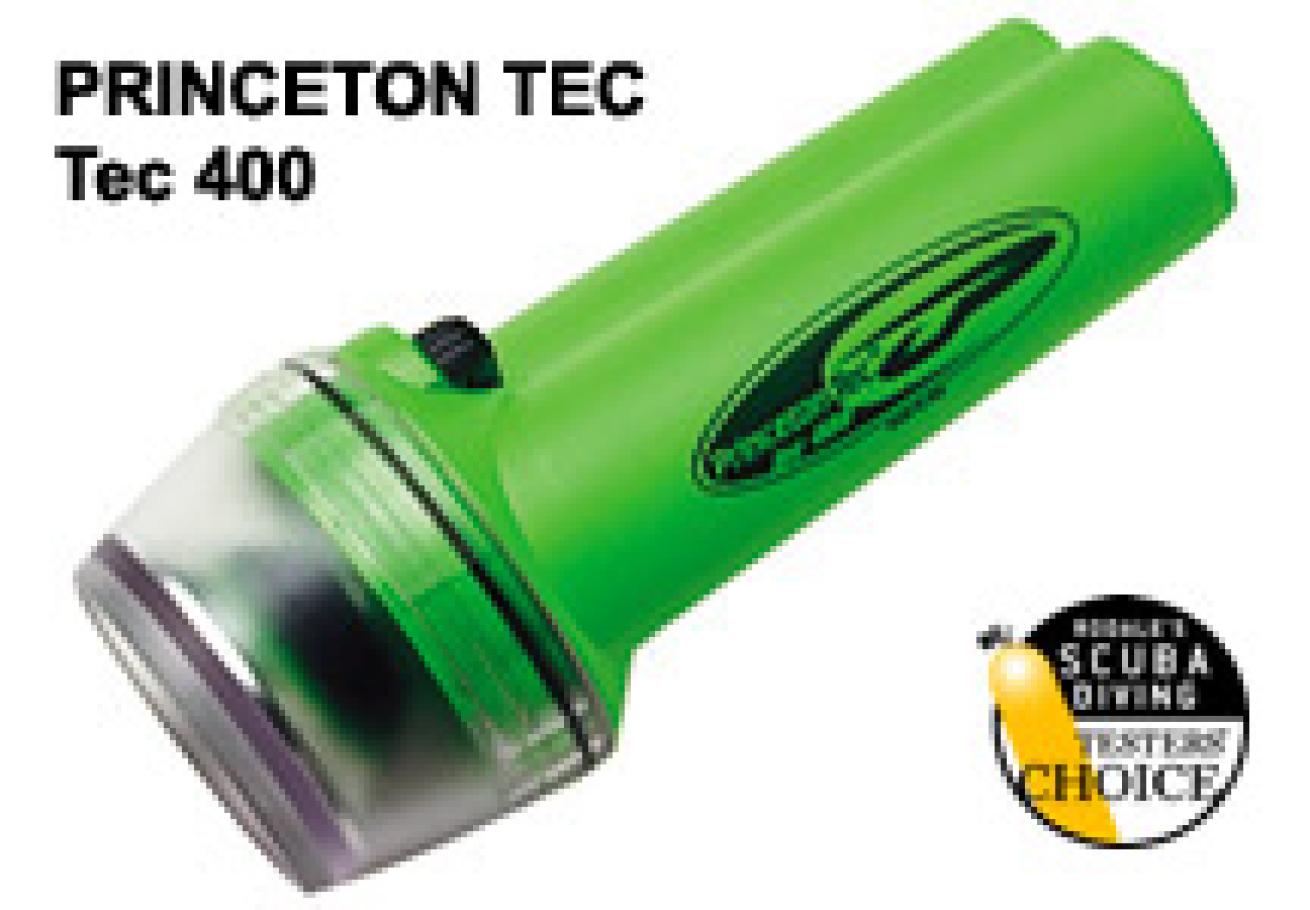
MEDIUM PRIMARY DIVE LIGHT. Princeton Tec's Tec 400. Perfect as a mid-sized primary dive light in clear water (or a back-up in murky conditions), the Tec 400 runs on four C-cells. An efficient incandescent bulb produces a bright hotspot, good peripheral illumination and no misleading shadows. Price: About $35. Close runner-up: Ikelite PCa, a bright, palm-sized light that takes 6 AA batteries, about $30.
MARKER LIGHT. Innovative Scuba VIP Safety Light. Amber LEDs make this marker light unusually bright yet energy-efficient. Price: About $80. Close runner-up: Innovative Scuba Versa-Lite, about $13.
TOPSIDE FLASHLIGHT. Tektite Expedition 1900. Save your dive light for underwater use. Topside, use this waterproof, drop-proof beam to find your way to the dock and rummage through your dive bag. Nineteen LEDs offer a long burn time and a wide, smooth light pattern. Price: About $116.
Light Buying Tips
Look for a floodlight, not a spotlight. Most of the time, you want to bathe a large area up-close with light, not pick out a dot at long distance.
Look for a smooth, featureless pool of light. A smooth pool is important because shadows of the filament or reflector when painted on the reef can be misleading.
In general, look for more batteries (six or eight) if you want a brighter light; look for bigger batteries (C or D cells) if you want longer burn time.
Bulbs and reflectors being equal, high intensity discharge bulbs are almost always much brighter than conventional incandescents, while LEDs are much easier on batteries.
Look for a one-finger on/off switch. Twist types require an extra hand.
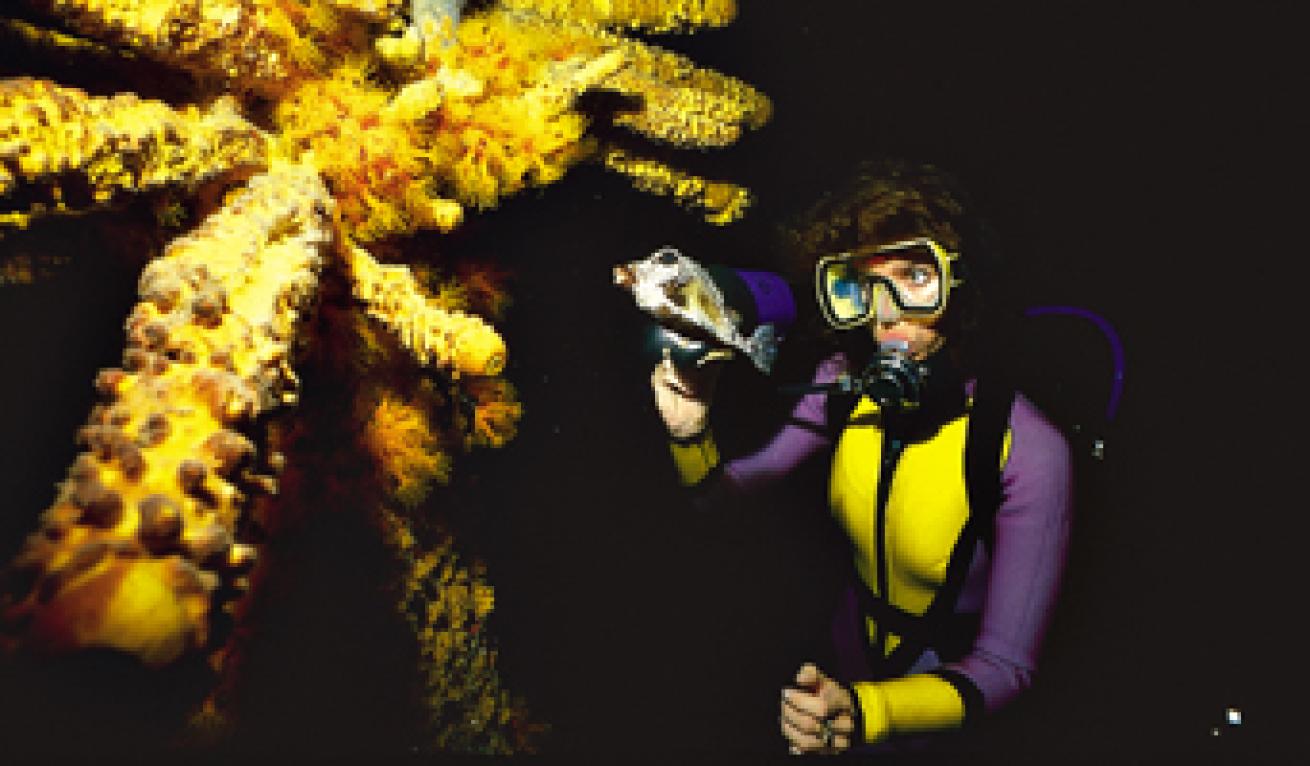
Now closed, you used to find Bonaire's best nightlife under Town Pier.
Book: The Coral Reef at Night, by Joseph Levine and photography by Jeffrey L. Rotman. Hardcover, 192 pages, $39.95.

